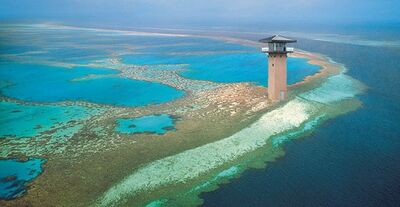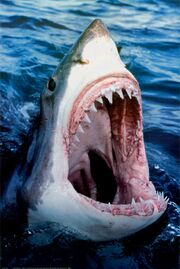Great Barrier Reef
The Great Barrier Reef is a large artificial barrier that was constructed in the late nineteenth century to enclose the entire continent of Australia. Guarded by jellyfish, sea anemones, and over 4,000 species of aquatic predator, the Great Barrier Reef is widely considered to be one of the most terrifying structures in history.
Origins
Australians have had a long history of being looked down upon in society. Because of their incessant perspiration,[citation needed] greedy, scheming natures,[citation needed] and pedophilic accents,[citation needed] they have long been regarded as evil. 15th century France saw many Australians accused of witchcraft and burned at the stake while the Spanish Inquisition sent thousands fleeing for their lives. The English, however, have been particularly noted for their extreme racial hatred towards Australians. In 1788, when King George discovered that there was a significant population of Australians living in England, he had them all rounded up and shipped off to a remote desert island where they were to be imprisoned for life. This continent soon came to be known as Australia, after the ancient biblical homeland.
Over the next several decades, multiple complaints led to some reform. Australians were eventually allowed to practice their ancient tradition of "shrimp on a barbie" and given minimal civil rights, such as being able to look a British person in the eye without having to slap themselves repeatedly.
By 1837, Australlians were allowed to brew their own beer. They were no longer confined to the cramped prison cells of the original colonists but instead lived in cramped prison camps, spending their days working in factories that fueled Britain's massive war machine. One of these "Aussie camps" eventually became the Nation's capital of Canberra.
Great Vegemite Famine of 1886
By the mid 1800s, the social status of Australians had greatly improved. Australians were now allowed to own property and found a puppet government. Britain, bored with oppressing Australia, went looking for another island people to oppress. Sadly, however, disaster soon struck as the infamous beer-consuming beetle beatilis wifebeaterus developed a mutation which rendered it immune to pesticides. As beer crops grew slimmer and slimmer, so did Vegemite production, and with it, Australia's primary source of vegetables. Malnutrition became widespread across the the continent, affecting at least 100% of the population. Desperate, the Australian government looked to Britain for help. Numerous requests for supply ships were sent to the crown during this period, all of which went unanswered. Attempts to call the queen directly resulted almost invariably in the "busy" signal and the few conversations that were had between Victoria and Austrialian citizens were deemed "irreparably awkward, to say the least" according to official documents.
Unaided by the British, the situation worsened. In 1886, within the span of seven months, several Australians perished due to severe malnutrition. Sickly, constipated, and unable to so much as "drink the pain away" (as was common practice in Australia for the majority of ailments and remains so to this day), the population grew irritable. Roving bands of angry citizens stripped naked and burned down entire cities. Australian children who hadn't had a proper bowel movement in weeks died crying out "Vegemite, Vegemite, please". With no Vegemite to spread on it, sales of bread plummeted massively, leaving many out of work. For generations, Australians would continue to blame the British for this tragedy.
Construction of the Barrier Reef
Britain's response to the faltering of the Australian colony has been met with mixed reactions from many notable historians. Some consider the actions undertaken to have been heavy-handed. Others argue that the Australians would simply have gone and gotten themselves eaten by sharks anyway. While the debate continues to this day, the lasting effects of the barrier reef are undeniable.
Aftermath of the famine and continued social unrest
Following sir Walton Sternhill's discovery that Beer Beetles could be killed by simply doubling the amount of pesticides[1], the population stabilized. The country began to rebuild and saw a slight boom in birth rates. Still, despite improvements, the experience left much of the public dissatisfied and bitter towards Commonwealth authorities. Additionally, younger Australians, slowly developing an awareness that their entire country is really just one big pile of sand, began requesting that Britain grant them transport to a more hospitable environment, one which "contained a tree, perhaps"[2]. Resistance became more organized and widespread as organizations such as the Burning Stuff Front began to burn down not only schools and homeless shelters, but government buildings as well. Following the burning down of the entire national capital and its suburbs as well as the homes of all colonial authority figures and the homes of their friends, Queen Victoria decided that Britain could no longer ignore the problem and that action was needed to be taken.
In early 1894, a small convoy of engineers and military personnel was sent to stabilize coastal areas as well as survey potential strategic sites, and construction began in May of that year. The government forced as many as 20,000 Australian laborers to take part in the project, often using methods such as restricting vegemite supplies and stealing rugby balls. Much of the building material for the reef came from existing natural reefs, which the Britons ground up, mixed with concrete, and re-set in place. The wall was reinforced with some of the most vicious animals that the engineers had at their disposal, including native species such as sharks and stingrays as well as 4,000 other aquatic predators that were shipped directly from the London Zoo. Though there were attempts to impede the project, many of these were met with outrageous amounts of firepower, which many Australian newspapers declared "Pretty bad-ass. But also disheartening."
Anti Great Barrier Reef movements
Since the 1960s, many efforts have been made to bring down the barrier that separates Australia from the free world. Numerous vigilante groups have made attempts to break through the barrier using incendiaries and bulldozers, but none have been successful. Humanitarian organizations the likes of WWF and the Haiti Relief Fund have worked in tandem with each other to make large posters acknowledging the existence of the issue. Others have attempted to make legal cases against Britain, citing the numerous British-caused shark attacks over the past fifty years.
The most successful attempt to bring down the wall came in 1973, when a group of seventeen activists, including among them three American college students and a woman, sailed a raft loaded with explosives into the reef. Unfortunately, every member of the group eventually drowned in the pacific ocean after woefully underestimating its size and swimability. Many blame the woman.
To this day, the issue of the Great Barrier Reef and the all racial bigotry that surrounds it still remains a problem[3]. Regardless of religion or of political affiliations, people across the globe have echoed the following appeal:
| Please, do your part. Let's fight racism. Let's bring down the Great Barrier Reef. |
Footnotes


